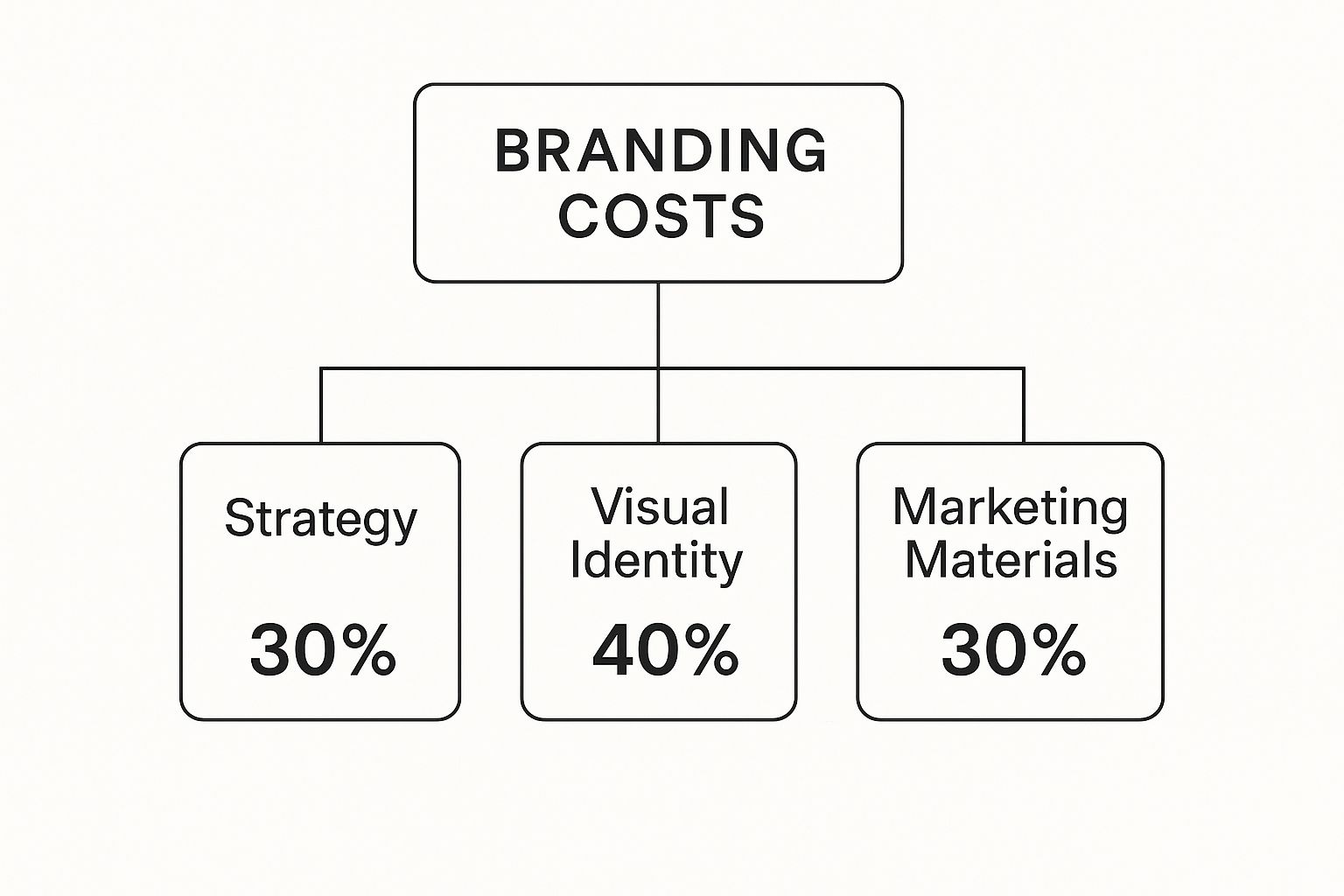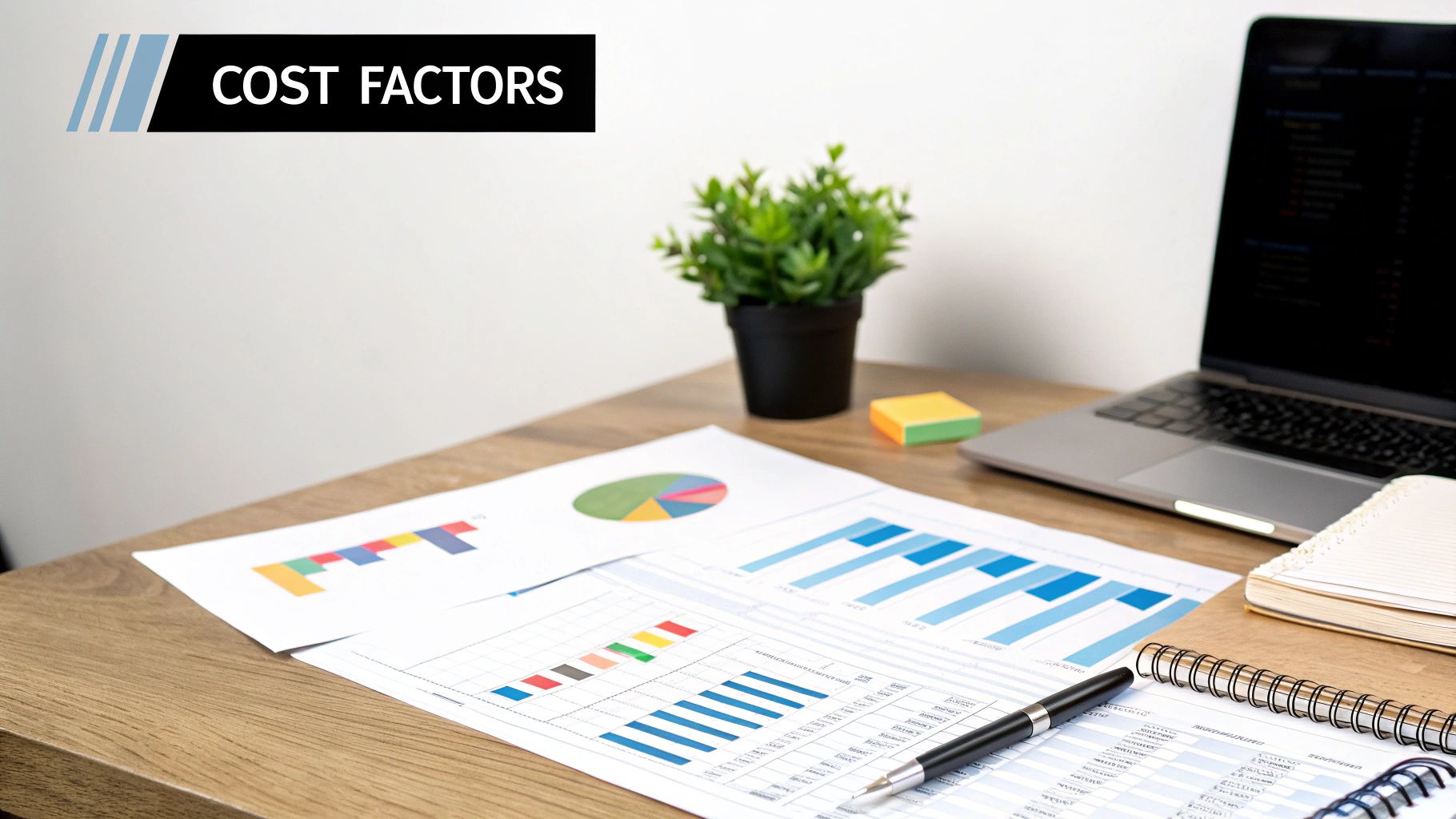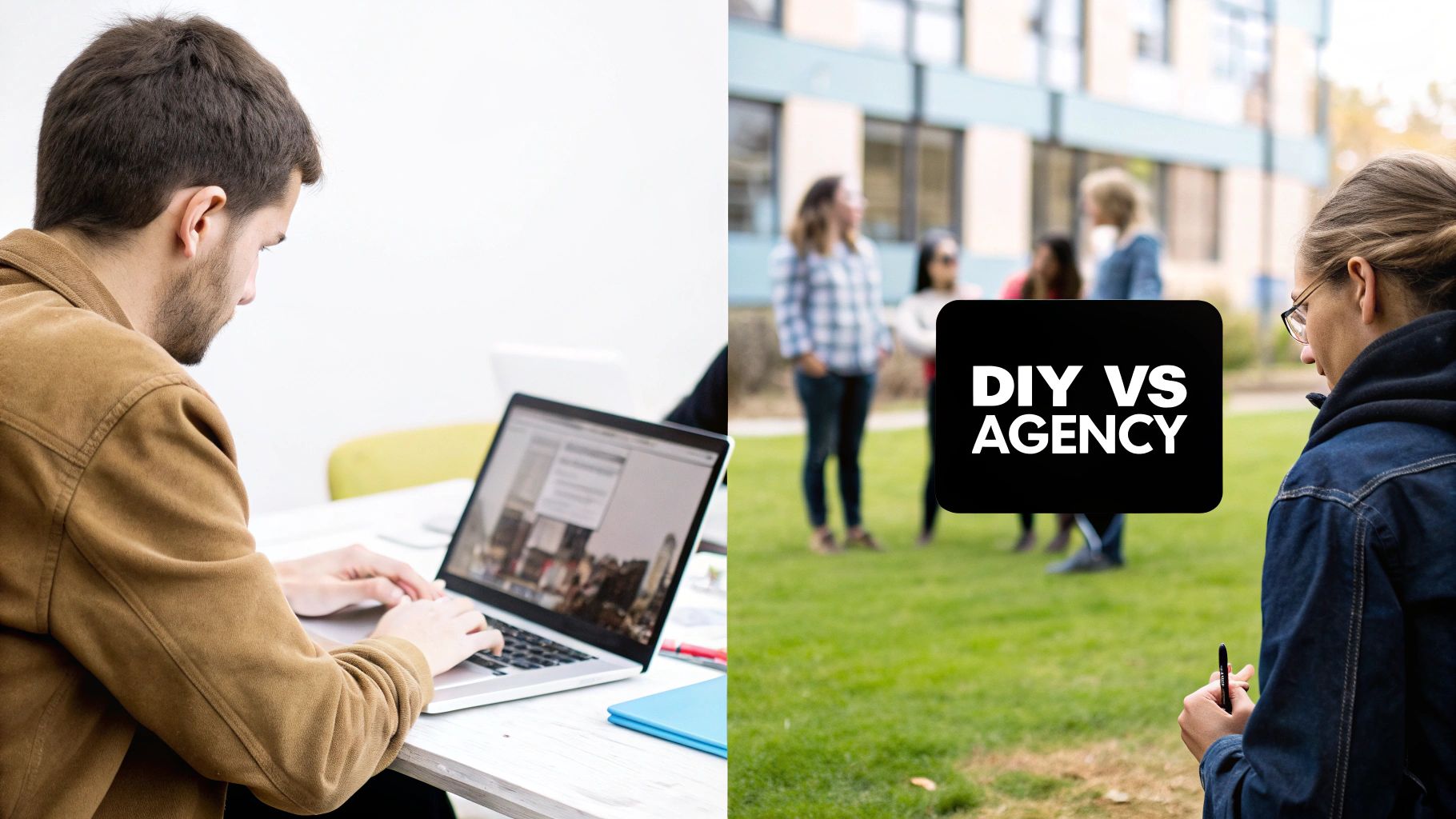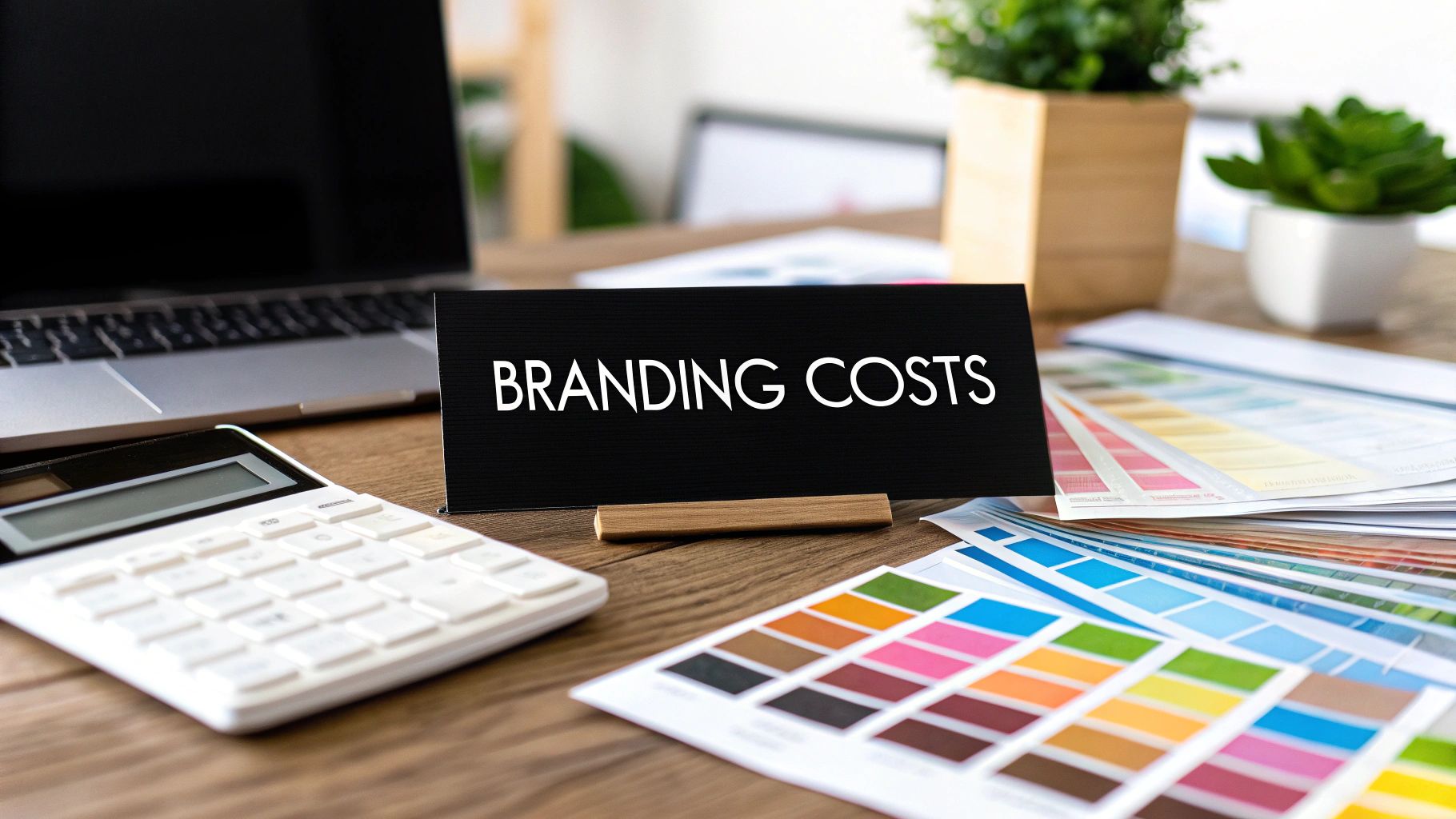So, how much should you budget for branding? The answer can be anything from $500 for a quick logo from a freelancer to well over $70,000 for a full-blown agency overhaul. The final price tag really boils down to your specific business needs, the size of the project, and who you choose to bring your brand vision to life.
Your Quick Guide to Branding Costs

Figuring out branding costs isn't like picking an item off a shelf with a set price. It's more like commissioning a custom piece of art or building a house—the final cost depends entirely on the materials, the complexity, and the expertise of the person doing the work. A simple logo from a designer who's just starting out will naturally cost a lot less than a complete rebrand from a top-tier agency with decades of experience.
Ultimately, your investment is tied directly to the depth of work you're getting. Are you just looking for a quick visual refresh, or do you need a deep, strategic foundation that will steer your business for years? Answering that question is the first step in understanding the final price.
A Snapshot of Branding Investments
To give you a clearer picture, your investment will vary widely based on who you hire and what you ask them to do. According to industry data, freelancers might charge anywhere from $500 to $5,000 for their services. A boutique agency will likely fall in the $5,000 to $20,000 range, while a comprehensive package from a larger firm could run from $11,000 to $70,000 or more. For a deeper dive into how these costs break down, check out this great resource on branding costs from Tenet.
A full-service branding package isn't just about a logo; it often includes a deep strategic analysis, a complete visual identity system (think colors, fonts, and imagery), and even detailed web design.
To make this easier to visualize, here’s a quick overview of what you can generally expect to pay, broken down by who you work with and the scope of services they typically offer.
Estimated Branding Costs by Provider and Scope
As you can see, the "right" price is the one that aligns with your specific goals and the level of expertise required to achieve them. A startup's needs are vastly different from those of an established corporation looking to rebrand, and the pricing reflects that.
What Are You Actually Paying For in Branding?
When you ask, "how much does branding cost," it’s easy to just think of a logo. But that’s like asking the price of a house and only considering the front door. A real investment in branding is a complex process with many layers, a lot like building a house from the ground up. You’re not just buying one thing; you're funding the entire construction.
It all starts with the most important part, which is also the part you can't see: the blueprint. This is your brand strategy.
The Blueprint: Brand Strategy
Long before anyone sketches a single logo, a solid strategy has to be in place. This is the foundational work that maps out your company's purpose, personality, who you're talking to, and what makes you different. It answers the big questions: Who are you? Who is this for? And why should they care?
A brand strategy session might cost a few thousand dollars on its own, but it guides every single decision that comes after. Without this blueprint, any design work is just a shot in the dark—and that's an expensive, risky way to build a business.
The Architecture: Visual Identity
Once the blueprint is locked in, it's time to actually build the house. This is your visual identity—the tangible things people will see and touch. This is where most of the creative magic happens, and it's often where a big chunk of the budget is spent.
Key parts of a visual identity include:
- Logo Design: This is the face of your brand, but as our guide to logo design pricing explains, it's just one piece of a much bigger puzzle.
- Color Palette & Typography: The specific colors and fonts that create a consistent, recognizable style.
- Imagery & Iconography: The unique style of photos, illustrations, and icons that tell your brand's story.
All these pieces have to work together to create a cohesive experience, turning that strategic blueprint into something your audience can actually connect with.
A well-crafted brand is more than a visual asset; it’s a strategic tool that builds trust and differentiates you from the competition, making it a powerful driver of long-term business value.
The Owner's Manual: Brand Guidelines and Assets
Finally, every new house needs an owner's manual. Your brand guidelines are exactly that—a detailed document showing your team how to use the new identity correctly and consistently everywhere. This is what keeps your brand strong and recognizable as your business grows.
This stage also involves creating the practical marketing materials you'll need. To really get a feel for what you're paying for in modern branding, it helps to look at specific pieces, like understanding the cost of AI video ads production.
This chart breaks down how a typical branding budget gets split across these core areas.

As you can see, the visual identity often takes the biggest slice of the pie, but the strategic foundation and the practical assets are just as crucial for a successful launch.
Key Factors That Influence Your Branding Cost

Ever wonder why one business pays $2,000 for branding while another drops $50,000? It’s not a random number pulled from a hat. The final bill comes down to a few key variables that directly shape the investment.
Getting a handle on these factors is the first step to setting a realistic budget and truly understanding what you’re paying for.
The biggest driver of your branding cost is the scope of the project. Think of it like a home renovation. Are you just repainting a single room, which is a lot like getting a simple logo design? Or are you building a whole new extension—a full rebrand complete with a new website? It’s simple: the more you need, the higher the investment.
A basic project might just cover a logo and a simple style guide. On the other hand, a full-scale branding initiative can be much more involved, including deep market research, brand strategy workshops, coming up with a name, crafting your messaging, and building out an extensive visual identity system.
The Experience of Your Creative Partner
Next up is who you hire. Just like a seasoned architect charges more than a fresh graduate, an experienced branding agency will have a higher price tag than a freelancer just starting out. You're paying for their track record, their strategic brainpower, and a process you can count on.
You can often find talented freelancers on platforms like Upwork or Fiverr for $500 to $2,500. In stark contrast, an established agency with a full team of strategists, designers, and writers might charge anywhere from $25,000 to $70,000+ for a comprehensive project.
Choosing a partner is really a balancing act between your budget and your appetite for risk. A seasoned agency brings a proven process and a team of specialists, which lowers the chances of costly mistakes and helps ensure the final result actually helps your business grow.
The Complexity and Number of Deliverables
Finally, the sheer volume and complexity of the assets you need play a huge role. A B2B software company might only require a straightforward corporate identity. A consumer goods brand, however, will need a whole lot more to get ready for store shelves.
Think about all the specific things your business needs to function:
- Packaging Design: Creating unique, print-ready designs for physical products isn't a small task. With an agency, this can run from $5,000 to $10,000 for a single packaging system.
- Website Design: A custom website design—just the design, not the coding—can start at $5,000 for a basic layout and climb quickly from there.
- Marketing Collateral: This is the catch-all for everything else, from social media templates and business cards to brochures and trade show banners.
Every single one of these deliverables adds time and resources to the project, which directly bumps up the final cost. That’s why a long list of required assets will naturally lead to a bigger investment. If you can clearly define your needs upfront, you'll not only get a much more accurate estimate but also have more productive conversations with any potential partners.
Freelancers vs. Agencies: What's the Right Fit for Your Budget?
One of the biggest forks in the road when you're figuring out branding costs is who you hire to do the work. This isn't just about the final bill; it's about finding a partner who matches your goals, budget, and the kind of support you actually need.
Should you go with a solo freelance designer or a full-blown branding agency? Let's break it down.
The Freelancer Advantage
Hiring a freelancer is often the go-to choice for startups and small businesses, especially when the budget is tight and the needs are specific. Think of it as hiring a specialist.
- Lower Costs: Freelancers don't have the big overhead of an agency (no fancy office, no project managers, no sales team), so their rates are almost always more accessible.
- Direct Communication: You're talking directly to the person doing the creative work. This means feedback is faster, and there’s less chance of things getting lost in translation.
- Flexibility: Need a quick turnaround on a small project? A freelancer can often be more nimble and adapt without the formal processes of a larger company.
This route is perfect if you already have a pretty clear vision and just need a talented designer to execute it visually.
The Power of an Agency
If you’re looking for more than just a logo—if you need a deep, strategic partner to help you build a brand from the ground up—an agency is probably the way to go. You're not just buying design; you're buying a proven process and an entire team.
An agency isn't just creating a pretty logo. They’re building a strategic foundation that connects your business goals to your brand identity, making sure it’s engineered to drive growth and carve out your space in the market.
This comprehensive approach is why the demand for top-tier branding is surging. The global market for branding agencies is expected to hit a staggering $42,213.3 million by 2025, jumping from $34,032.3 million in 2021.
This trend says a lot. It shows that more and more businesses see strategic branding not as a cost, but as a critical investment for staying competitive. If you're curious about what's driving this, you can explore the research on brand agency trends to see the full picture.
So, what's the verdict? It really boils down to what you need. A freelancer is your specialist for a well-defined task. An agency is your long-term strategic partner for building an entire brand ecosystem.
Why Smart Branding Is a Valuable Investment

It’s tempting to look at the price tag for branding and lump it in with all the other expenses. I get it. But that’s a short-sighted way to look at it.
A much better approach is to see branding for what it truly is: one of the most powerful investments you can make in your company's future. It's an asset that, when done right, only grows in value over time.
Smart branding is so much more than a pretty logo. It's the invisible thread that weaves a connection between you and your customers. It’s what inspires fierce loyalty, gives you the backbone to charge what you're worth, and makes you the obvious choice in a sea of competitors. When your brand is consistent, authentic, and clear, it builds trust—the bedrock of any real business relationship.
And in a world this noisy, that trust is everything. Marketers are on track to spend nearly $1.1 trillion globally on advertising. With that much shouting, a memorable brand is the only thing that keeps your marketing budget from vanishing into thin air.
From Expense to Asset
Shifting your mindset from "expense" to "investment" changes the entire conversation around cost. You’re not just paying for a logo or a color palette; you’re building a long-term competitive advantage. That perspective is absolutely crucial if you're serious about sustainable growth.
A strong brand delivers real, tangible returns. Here’s how:
- Higher Customer Lifetime Value: People stick with brands they love. This loyalty turns one-time purchasers into repeat customers and, eventually, vocal advocates for your business.
- Increased Perceived Value: Solid branding gives you pricing power. Just think about it—a Lexus can sell for far more than a Toyota, even when they share many of the same parts. That's the power of brand perception at work.
- Improved Recruitment: A respected brand doesn't just pull in customers; it attracts top-tier talent. It makes building a team of A-players that much easier.
A brand is the sum of every single interaction someone has with your company. A great brand isn't just seen; it's felt. It’s the gut feeling that makes someone choose you over a nearly identical competitor and be happy they did.
Making the Investment Work for You
At the end of the day, the goal is to build an asset that pays you back for years. You’re creating a reputation that walks into the room before you do and an identity that connects so deeply with your audience that they wouldn't consider going anywhere else. For smaller companies, there are some essential branding tips for small business success that can make a huge difference.
By focusing on the long-term value instead of getting hung up on the initial cost, you can make a strategic decision that fuels growth and sets your business on a path to success. Understanding how much branding costs is just the start; appreciating what it’s worth is what really matters.
How to Budget for Your Branding Project
Knowing what branding can cost is the first step, but figuring out how to actually pay for it is the real challenge. Creating a smart budget turns a potentially scary expense into a calculated investment in your future. It’s all about planning ahead so you get the most bang for your buck without breaking the bank.
Before you even glance at a price list, you need to get crystal clear on your goals. What do you really want this branding to achieve? Are you launching a new product and need to make a splash? Trying to reposition your company so you can charge premium prices? Maybe you’re looking to attract the best employees in your industry.
Each of these goals demands a different approach and, naturally, a different budget. A tech startup wooing investors will need a slick, comprehensive brand identity right out of the gate. A local coffee shop, on the other hand, might just need a great logo and menu to get started. Pinpointing your objective keeps you from spending money on things you don't need right now.
Build Your Budget Step by Step
With clear goals in mind, you can start putting together a realistic budget. This isn't about complex spreadsheets; it's about being honest about what you can afford and what your business truly needs to move forward.
Here’s a simple way to think about it:
- Define Your Scope: Get specific. Make a shopping list of every single thing you need. Is it just a logo? Or do you need the whole shebang—a new website, social media templates, business cards, and product packaging? The more detailed your list, the more accurate your quotes will be.
- Request Multiple Proposals: Don't just go with the first person you find. Talk to at least three different agencies or freelancers. This gives you a much better sense of the going rate and lets you compare their process and what you get for the price, not just the final number.
- Plan for Contingencies: Things happen. Ideas change, or unexpected needs pop up mid-project. Always build a little wiggle room into your budget. A good rule of thumb is to add an extra 10-15% as a buffer. This safety net will save you a ton of stress later on.
Phasing Your Investment
What if your dream branding project is just too expensive right now? Don't panic, and definitely don't settle for cheap, low-quality work. Instead, think about tackling it in phases.
Start with the absolute essentials: your brand strategy and core identity (logo, colors, fonts). Once those are locked in, you can add the other pieces—like a full-blown website or fancy marketing materials—as your business grows and generates more revenue.
A phased approach means you can build a rock-solid brand foundation today, even on a tight budget. You invest in the strategic thinking first and then layer on the other components when the time is right.
This strategy makes professional branding accessible, not just something for the big players. For a closer look at how these phases can be structured, check out these branding packages for small businesses.
And if your marketing plan includes working with creators, make sure you understand the costs involved. Learning about effective strategies for paying influencers will help you factor those expenses into your overall budget. A little careful planning goes a long way in making a smart, scalable investment in your brand.
Common Questions About Branding Costs
Diving into the world of branding costs can feel like navigating a maze. It’s totally normal to have questions, and getting straight answers is the first step to making a smart decision for your business. Let's clear up some of the most common things people ask.
How Much Should a Small Business Budget for Branding?
There's no single magic number, but we can definitely talk in realistic ranges. If you're a small business just getting off the ground, a basic identity package from a good freelancer is a great starting point. This usually includes a logo, a color palette, and your brand fonts, and you can expect to budget anywhere from $1,000 to $5,000.
Now, if you're looking for something more than just the visuals—like a deep dive into your market position and messaging—you'll want to look at a boutique agency. For a project that includes brand strategy and comprehensive guidelines, the investment typically falls between $8,000 and $20,000. The trick is to figure out what you need right now and build a solid foundation you can add to later.
A huge piece of that foundation is your logo. If you want to get granular on just that one element, check out our guide on how much logos cost.
Is Paying for a Brand Strategy Session Worth It?
One hundred percent, yes. In fact, if you skip anything, don't let it be this. A brand strategy session is the blueprint for your entire brand. It's where you nail down who you are, who you're talking to, and what makes you different from everyone else.
Trying to build a brand without this step is like trying to build a house without architectural plans. You might end up with four walls and a roof, but it won’t be sturdy or designed for how you actually live. Investing in strategy first makes sure every design choice, every social media post, and every ad has a purpose. It saves you from costly and confusing rebrands down the line.
What Is the Difference Between Branding and Marketing Costs?
This is a classic point of confusion, so let's use an analogy: branding is building the car, and marketing is driving it.
- Branding is all the upfront work to create your identity—the logo, the messaging, the visual style. Think of it as a one-time investment to build a high-performance vehicle.
- Marketing is the ongoing cost of putting that car on the road and getting it in front of people. This is your fuel: ad campaigns, social media, content creation, and so on.
Keeping this distinction clear helps you budget properly. You want to make sure you've built a solid car before you start spending a ton of money on gas.
Ready to build a brand that turns heads? At Softriver, we create custom logos and full brand identities with unmatched speed and quality. Get started today and see what top-tier design can do for your business.







